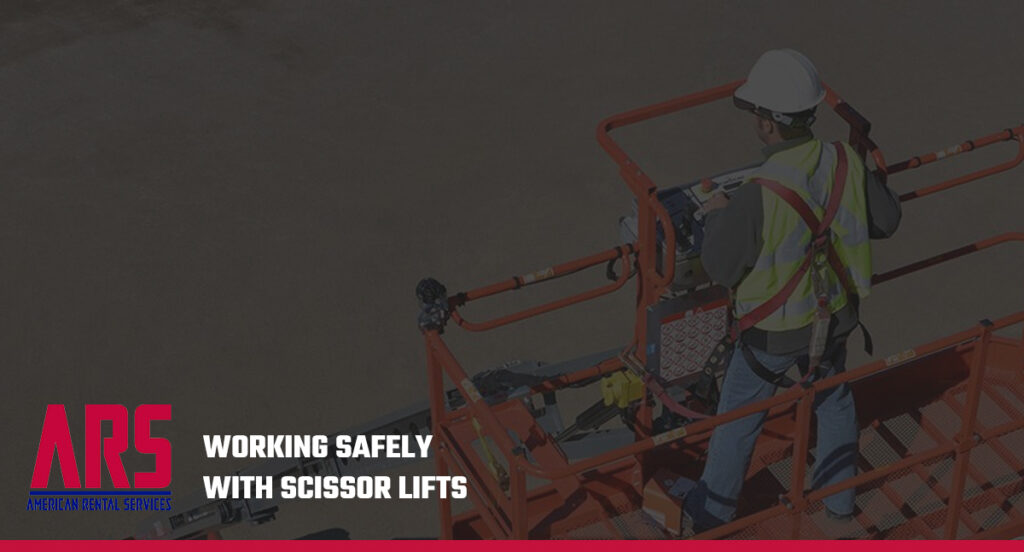
Scissor lifts provide a safe and reliable platform for workers to perform job tasks when used according to the manufacturer’s instructions. When not used properly, scissor lifts can present a serious hazard to workers. Employers are responsible for keeping workers safe. This Hazard Alert highlights specific hazards present in workplaces where scissor lifts are used and controls employers must implement to prevent injuries or fatalities.
Scissor lifts are work platforms used to safely move workers vertically and to different locations in a variety of industries including construction, retail, entertainment and manufacturing. Scissor lifts are different from aerial lifts because the lifting mechanism moves the work platform straight up and down using crossed beams functioning in a scissorlike fashion. Although scissor lifts present hazards similar to scaffolding when extended and stationary, using scissor lifts safely depends on considering equipment capabilities, limitations and safe practices.
Over a one-year period, OSHA investigated ten preventable fatalities and more than 20 preventable injuries resulting from a variety of incidents involving scissor lifts. OSHA’s investigations found that most injuries and fatalities involving scissor lifts were the result of employers not addressing:
- Fall Protection
- Stabilization
- Positioning
How to Safely Use Scissor Lifts
Employers need to assess the worksite to identify all possible hazards in order to select the appropriate equipment for the task. Employers who use scissor lifts need to evaluate and implement effective controls that address fall protection, stabilization and positioning. Only trained workers should be allowed to use scissor lifts, and employers should make sure that those workers show that they can use a scissor lift properly. Safe scissor lift use includes properly maintaining the equipment, following the manufacturer’s instructions, providing workers training and needed personal protective equipment (PPE), and implementing safe work practices.
Fall Protection
Scissor lifts must have guardrails installed to prevent workers from falling (see 29 CFR 1926.451(g) or 29 CFR 1910.29(a)(3)(vii)).
Employers should train workers to:
- Check to see that a guardrail system is in place before working on the scissor lift.
- Only stand on the work platform; never stand on the guardrails.
- Keep work within easy reach to avoid leaning away from the scissor lift.
Stabilization
Employers should ensure that scissor lifts are stable
and will not tip over or collapse. Some safe work
practices to ensure safe, stable conditions for scissor
lift use include:
- Follow the manufacturer’s instructions for safe movement—this usually rules out moving the lift in an elevated position.
- Isolate the scissor lift or implement traffic control measures to ensure that other equipment cannot contact the scissor lift.
- Select work locations with firm, level surfaces away from hazards that can cause instability (e.g., dropoffs, holes, slopes, bumps, ground obstructions, or debris).
- Use the scissor lift outside only when weather conditions are good. Scissor lifts rated for outdoor use are generally limited to wind speeds below 28 miles per hour.
Although rare, the collapse of scissor lifts can be prevented if employers:
- Ensure that safety systems designed to stop collapsing are maintained and not bypassed.
- Never allow the weight on the work platform to exceed the manufacturer’s load rating.
- Never allow equipment other than the scissor mechanism to be used to raise the work platform (e.g., using a forklift to lift the work platform)
- Keep the lift from being struck by other moving equipment on the worksite.
Positioning
Positioning the scissor lift to avoid crushing or electrocution hazards is important for safe use.
Crushing hazards are present in workplaces using scissor lifts and may expose workers nearby, even those not working on the scissor lift.
Scissor lifts present crushing hazards similar to vehicles and other mobile equipment at worksites. Employers should train workers to be watchful when:
- A moving scissor lift is near a fixed object.
- A moving vehicle and the scissor lift are operating closely.
- The scissor lift passes under a fixed object, such as a door frame or a support beam.
Positioning the scissor lift to avoid electrocution, arc flash, and thermal burns is important for safely using scissor lifts near energized power lines. Since electricity can arc or jump from the power line to the scissor lift or worker, electrocution can occur even if neither the scissor lift nor the worker touches the power line.
Employers should use the following work practices to ensure that scissor lifts are safely positioned:
- Implement traffic control measures around the scissor lift to prevent other workers or vehicles from getting too close.
- Use ground guides when operating or moving the scissor lift around the workplace.
- Select work locations that do not approach electrical power sources (e.g., power lines, transformers) by at least 10 feet and that do not pose other overhead hazards (e.g., other utilities, branches, overhangs, etc.).
- If the job task requires work near an electrical source, ensure that the worker is qualified and has received the required electrical training. (29 CFR 1910.269; 29 CFR 1910.333; 29 CFR 1926 Subpart V).
Maintaining Scissor Lifts
Employers must regularly maintain scissor lifts to ensure that they are safe to use (e.g., prevent the lifting mechanism from collapsing). Manufacturer’s maintenance and inspection instructions will generally include how to:
- Test and inspect controls and components before each use.
- Ensure that guardrail systems are in good working condition.
- Verify that brakes once set will hold the scissor lift in position.
Sources:
- https://www.osha.gov/sites/default/files/publications/OSHA3842.pdf
- https://www.osha.gov/etools/scaffolding/scissor-lifts
American Rental Services focuses on re-renting aerial high-lift equipment to rental companies throughout North America. Partner with American Rental Services to improve your bottom line at no risk, using wholesale big booms and large-reach forklifts.
